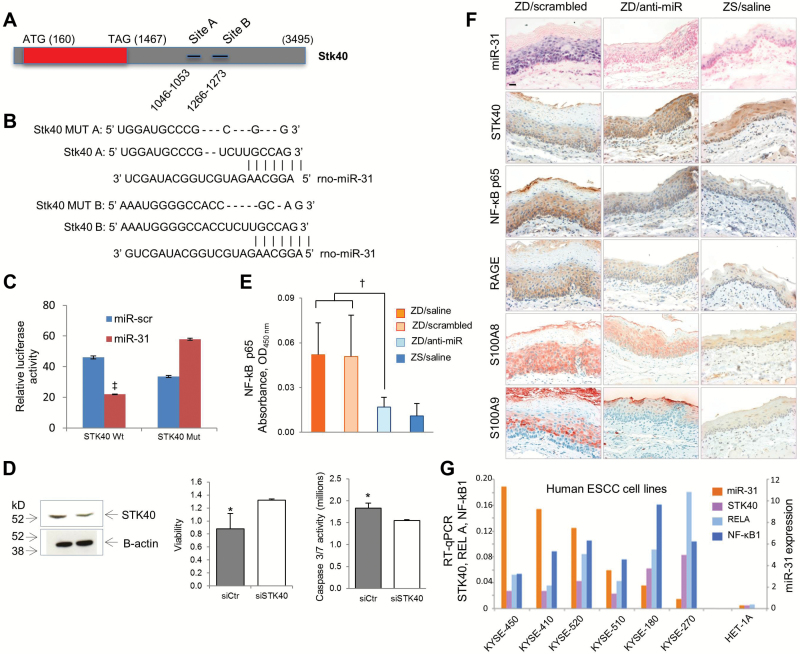Figure 4.
Anti-miR-31 effects on Stk40-NF-κΒ–based inflammatory signaling. A-C) Stk40 3’ UTR is a miR-31 direct target. A) Stk40 3’UTR presents two miR-31 binding sites. B) Alignment of miR-31 seed region with Stk40 3’UTR. Sites of target mutagenesis are indicated (- = deleted nucleotides). C) Luciferase reporter assays indicates direct interactions between miR-31 and Stk40. Error bars represent standard deviation. ‡P < .001. D) STK40 silencing affects proliferation and apoptosis of esophageal squamous carcinoma (ESCC) cells. Western blot showing STK40 downregulation in KYSE-70 ESCC cells after transfection with STK40 siRNA; cell proliferation assay showing increased cell survival (*P = .03, error bars represent standard deviation), and luminescent assays showing decreased caspase 3/7 activity after STK40 silencing (*P = .015, error bars represent standard deviation). E) Enzyme-linked immunosorbent assay shows NF-κΒ p65 expression was statistically significantly reduced in Zn-deficient (ZD)/anti-miR vs control ZD cohorts (n = 6–8 rats/group, Tukey-HSD post hoc unpaired t test, †P = .002). Error bars represent standard deviation. F) In situ hybridization (ISH) analysis of miR-31 expression; immunohistochemical analysis of STK40, NF-κΒ p65, RAGE, S100A8, and S100A9 expression in esophageal formalin-fixed, paraffin-embedded sections. ZD/anti-miR (middle) and ZS (right) esophagi showing weak/diffuse miR-31 ISH signal (blue, 4-nitro-blue tetrazolium and 5-brom-4-chloro-3′-indolylphosphate); strong cytoplasmic STK40 (brown, 3,3′-diaminobenzidine tetrahydrochloride [DAB]) but weak cytoplasmic NF-κΒ p65, RAGE (brown, DAB), and S100A8/A9 (red, 3-amino-9-ethylcarbazole substrate-chromogen) immunostaining. In contrast, hyperplastic ZD/scrambled esophagus (left) showing strong/abundant miR-31 ISH signal, weak/diffuse cytoplasmic STK40 immunostaining, but strong cytoplasmic immunostaining of NF-κΒ p65, RAGE, and S100A8/A9 protein. Scale bar = 25 μm. G) Quantitative polymerase chain reaction (qPCR) analysis of miR-31, STK40, RELA, and NF-κΒ1 expression in six human esophageal squamous cell carcinoma cell lines and control esophageal squamous epithelial cells HET-1A, using RNU44 and OAZ1 and as normalizer for miR-31 and mRNA, respectively. qPCR analysis was performed in triplicate. All statistical tests were two-sided. ESCC = esophageal squamous cell carcinoma; RT-qPCR = qualitative real-time polymerase chain reaction; ZD = Zn-deficient; ZS = Zn-sufficient.

